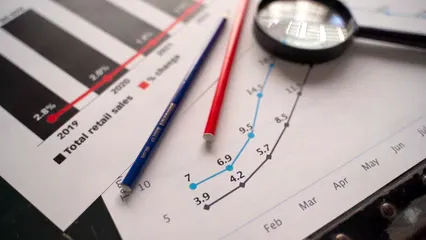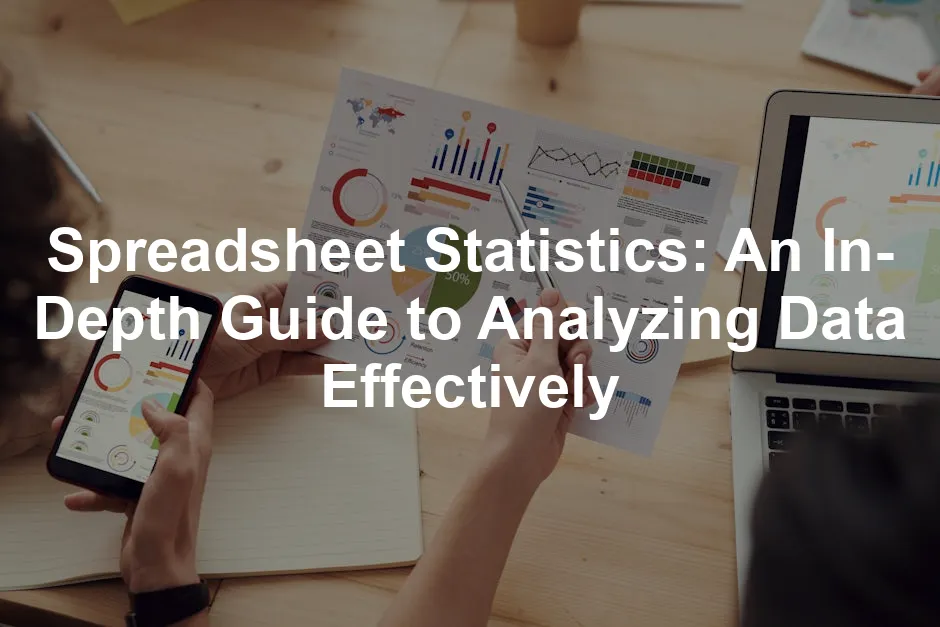Introduction
Spreadsheets are essential for statistical analysis. Tools like Excel and Google Sheets offer versatility. They simplify data manipulation and analysis for everyone. In this guide, we’ll cover various statistical functions and their practical applications in spreadsheets.
To really master your spreadsheet game, consider diving into Microsoft Excel 2021 for Windows. This powerful tool will unlock a new world of data analysis and help you impress your colleagues with your newfound skills!
Summary and Overview
Spreadsheet statistics involve using software to analyze data effectively. These tools find relevance in diverse fields, including business, education, and research. One major advantage is accessibility. You don’t need to be a statistician to use them! They are user-friendly and often free, making them cost-effective.
Common functions, like AVERAGE and STDEV, help summarize data quickly. Visualizations, such as charts, enhance understanding. This article will explore practical applications of statistical functions in spreadsheets. We’ll also share best practices to help you make the most of these powerful tools.

For those who love a good read, check out Google Sheets Essentials. This book is perfect for anyone looking to get the most out of their spreadsheet experience!
Understanding Spreadsheet Statistics
What Are Spreadsheet Statistics?
Spreadsheet statistics refer to the use of spreadsheet software for statistical analysis. This includes organizing, managing, and analyzing data to draw meaningful conclusions. Spreadsheets like Excel or Google Sheets simplify complex calculations, making them accessible to everyone.
You can perform various statistical analyses using spreadsheets. For instance, you can calculate averages, medians, and standard deviations. Additionally, you can conduct t-tests or ANOVA for comparing groups. These functions are invaluable in fields such as business, education, and research.
Have you ever thought about how you can analyze your own data effectively? Whether it’s sales figures, student grades, or research data, spreadsheets offer powerful tools to help you make sense of it all.
For anyone serious about data science, Statistics for Dummies is a great resource. It breaks down complex concepts into digestible pieces, making it a must-have for beginners!

Advantages of Using Spreadsheets for Statistics
Using spreadsheets for statistical analysis offers numerous benefits over traditional statistical software. For one, spreadsheets are cost-effective. Many people already have access to tools like Excel or Google Sheets, often at no cost.
Spreadsheets are user-friendly. They provide intuitive interfaces that anyone can learn to navigate. You don’t need extensive training to perform basic statistical functions. This accessibility encourages non-statisticians to engage in data analysis.
Another advantage is integration. Spreadsheets can easily connect with other data sources, allowing for seamless data import and export. You can combine data from multiple files or systems without hassle.
Speaking of integration, if you’re looking to step up your data handling, consider The Art of Data Science. It’s a fantastic read that will elevate your understanding of data analysis!
So, are you ready to explore the world of spreadsheet tools? Consider giving them a try for your next data analysis project!

Key Statistical Functions in Spreadsheets
Basic Statistical Functions
Mean, Median, Mode
Calculating the mean, median, and mode is straightforward with spreadsheet functions.
To find the mean, use the AVERAGE function. For example, =AVERAGE(A1:A10) computes the average of values in cells A1 through A10. This function is useful for summarizing data, like sales figures or test scores.
The median can be calculated using the MEDIAN function. For instance, =MEDIAN(B1:B10) returns the middle value of the dataset in cells B1 to B10. The median is beneficial when analyzing income data, as it helps to understand the central tendency without being skewed by outliers.
To determine the mode, apply the MODE.SNGL function. For example, =MODE.SNGL(C1:C10) identifies the most frequent value within the range C1 to C10. This is particularly useful in survey data, where you want to find the most common response.

For those who want to dive deeper into statistical functions, Data Visualization: A Practical Introduction is highly recommended. It’s a great way to learn how to present your data effectively!
Variance and Standard Deviation
Variance and standard deviation are vital for understanding data variability.
Variance measures how far each number in a dataset is from the mean. To calculate variance, use the VAR.S function for sample data, like so: =VAR.S(D1:D10). Knowing the variance helps assess the spread of test scores or sales data.
The standard deviation can be found using the STDEV.S function. For example, =STDEV.S(E1:E10) calculates how much the values in E1 to E10 vary from the mean. This metric is crucial for quality control. It indicates consistency in product measurements.
Understanding these functions allows you to analyze data distributions effectively. They provide insights into data trends, helping you make informed decisions based on statistical evidence.

For a more comprehensive understanding, The Data Warehouse Toolkit: The Definitive Guide to Dimensional Modeling will provide you with in-depth techniques for organizing your data!
Advanced Statistical Functions
Correlation and Regression Analysis
Understanding relationships between variables is crucial in data analysis. Correlation and regression functions help assess these connections effectively.
Correlation measures the strength and direction of a linear relationship. Use the CORREL function in spreadsheets to find the correlation coefficient. For example, =CORREL(A1:A10, B1:B10) computes the correlation between two datasets. A coefficient close to 1 or -1 indicates a strong relationship, while values near 0 suggest a weak correlation. To understand more about correlation, you can refer to this article on correlation.
Understanding correlation is key to analyzing relationships between variables effectively. correlation
Regression analysis takes this a step further. It models the relationship between variables, allowing predictions. You can perform linear regression using the LINEST function. For instance, =LINEST(B1:B10, A1:A10) returns the slope and intercept of the best-fit line.
Regression has practical applications across various fields. In finance, it predicts stock prices based on historical data. In healthcare, it helps assess the impact of treatments on patient outcomes. Marketing teams use regression to evaluate the effectiveness of advertising campaigns.
By understanding correlation and regression, you can uncover insights, make predictions, and support data-driven decisions. And if you want to dive deeper into using R for data analysis, check out R for Data Science. This book will guide you through powerful techniques!

T-tests and ANOVA
T-tests and ANOVA are essential for comparing groups in statistical analysis. They help determine if there are significant differences between means.
A T-test is ideal for comparing the means of two groups. Use the T.TEST function in spreadsheets. For example, =T.TEST(A1:A10, B1:B10, 2, 3) compares two datasets. You would use a T-test when your data is normally distributed and you have small sample sizes.
ANOVA (Analysis of Variance) is useful when comparing three or more groups. The ANOVA function in spreadsheets can help assess differences between group means. For instance, =ANOVA(A1:A10, B1:B10, C1:C10) evaluates the means of the three datasets.
Both methods rely on the concept of p-value. A p-value below 0.05 often indicates statistical significance. This means the difference observed is unlikely due to random chance.
Choosing between a T-test and ANOVA depends on your data. Use T-tests for two groups and ANOVA for three or more. These tests are invaluable for hypothesis testing in research, education, and business.
Understanding when to use each test will enhance your analytical skills and improve decision-making. And if you’re looking for a way to manage your office supplies while you analyze data, consider an Office Supplies Organizer to keep everything in check!

Best Practices for Data Visualization
Creating effective charts is vital for data visualization. When designing your graphs, keep these tips in mind:
1. Choose the Right Chart Type: Different data types require different visualizations. Use bar charts for comparisons, line graphs for trends, and pie charts for proportions. Selecting the right chart enhances understanding.
2. Prioritize Clarity: Your main goal is to convey information clearly. Avoid cluttering your charts with unnecessary elements. Keep it simple and focused.
3. Use Labels Wisely: Label your axes and provide clear titles. Descriptive labels help viewers understand what they are looking at without confusion. A well-labeled chart is more informative.
4. Incorporate Color Thoughtfully: Use color to distinguish different data series or categories. But avoid using too many colors, as this can overwhelm your audience. Stick to a cohesive color palette.
5. Highlight Key Data Points: If certain information is crucial, emphasize it. Use contrasting colors or larger markers to draw attention to important findings.
6. Test for Visual Clarity: Always step back and assess your chart. Ask yourself if someone unfamiliar with the data can understand it easily.

By following these best practices, you can enhance visual clarity and improve data interpretation. Remember, effective visualizations allow your audience to grasp complex data quickly and make informed decisions based on it.
Common Mistakes to Avoid in Spreadsheet Statistics
Errors in Data Entry and Management
Data entry mistakes can severely impact your analysis. Common pitfalls include typos, incorrect formatting, and misplaced values. To ensure data accuracy, consider these tips:
1. Double-Check Entries: Always review your data after inputting it. A small error can lead to incorrect conclusions.
2. Use Data Validation: Set up rules that restrict the type of data entered into cells. This can prevent common errors, such as entering text in a numerical field.
3. Keep a Backup: Regularly save copies of your data. This practice protects against accidental loss or corruption.
By focusing on data integrity, you ensure reliable analysis and informed decision-making. Remember, a solid foundation of accurate data is crucial for successful statistical work.

Misinterpretation of Statistical Results
Misinterpretation of statistical results can lead to misguided conclusions. Understanding the difference between statistical significance and practical significance is essential. Statistical significance indicates a result is unlikely due to chance, but it doesn’t imply that the result is meaningful in a real-world context.
For example, a small p-value might suggest a significant effect, but the effect size could be minimal. This discrepancy can mislead decision-makers. Being statistically literate is crucial for making informed decisions based on data.
To avoid misinterpretation, always consider the context of your results. Ask questions like: How large is the effect? Is it relevant to my situation? By understanding these distinctions, you can improve your decision-making process and better communicate findings to others.

Conclusion
Spreadsheet statistics play a crucial role in data analysis. They empower users to manage and interpret data effectively. By practicing spreadsheet functions, you enhance your data handling skills and improve your analytical capabilities.
Statistics is an ongoing learning process. Embrace opportunities to grow your understanding, and apply these skills in real-world scenarios. The more you practice, the more proficient you’ll become in using spreadsheets for statistical purposes. And remember, a good pair of Blue Light Blocking Glasses can help you stay focused while working on those spreadsheets!
Please let us know what you think about our content by leaving a comment down below!
Thank you for reading till here 🙂
All images from Pexels




